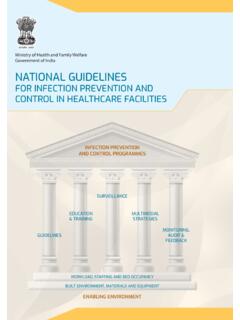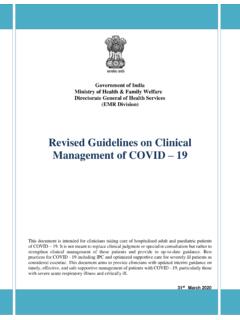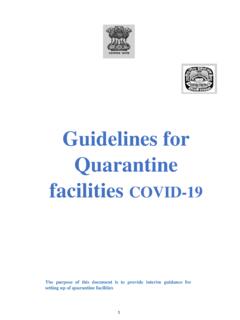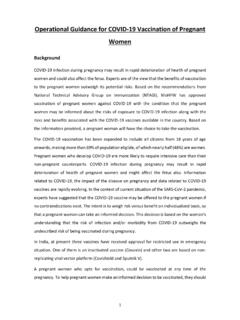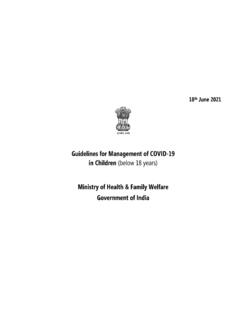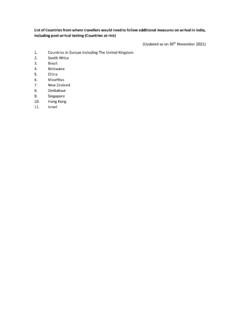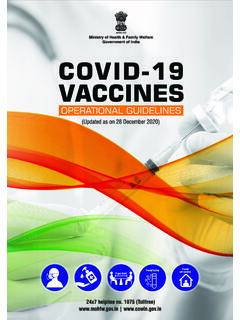Transcription of NATIONAL CLINICAL MANAGEMENT PROTOCOL COVID-19
1 CLINICAL MANAGEMENT PROTOCOL FOR COVID-19 (In Adults) Government of India Ministry of Health and Family Welfare Version 6 Table of Contents 1. Background ..2 2. Disease epidemiology ..2 3. Patho-physiology ..2 4. Case definition ..3 5. CLINICAL features ..3 6. Risk factors ..4 7. CLINICAL severity ..4 8. Infection prevention and control practices .. 7 9. Laboratory diagnosis .. 9 10. MANAGEMENT of COVID-19 .. 11 MANAGEMENT of mild cases .. 11 MANAGEMENT of moderate cases .. 12 MANAGEMENT of severe cases .. 14 11. Investigational therapies: .. 19 12. Prevention of complications .. 20 13. Patient discharge 14. MANAGEMENT of post-COVID 1. Background Coronaviruses are large group of viruses that cause illness in humans and animals.
2 Rarely, animal coronaviruses can evolve and infect people and then spread between people such as has been seen with MERS and SARS. The outbreak of Novel coronavirus disease ( COVID-19 ) was initially noticed in a seafood market in Wuhan city in Hubei Province of China in mid-December, 2019, has now spread to 215 countries/territories/areas worldwide. WHO (under International Health Regulations) has declared this outbreak as a Public Health Emergency of International Concern (PHEIC) on 30th January 2020. WHO subsequently declared COVID-19 a pandemic on 11th March, 2020. 2. Disease Epidemiology Current available evidence for COVID-19 suggests that the causative virus (SARS-CoV-2) has a zoonotic source closely related to bat-origin SARS-like coronavirus.
3 It is an enveloped RNA beta coronavirus related to the Severe Acute Respiratory Syndrome (SARS) virus, and the virus has been shown to use the angiotensin-converting enzyme 2 (ACE2) receptor for cell entry. The persons infected by the novel coronavirus are the main source of infection. At present, majority of the transmission is believed to occur predominantly through the airborne route and droplet released when the infected person coughs, sneezes, or talks. These droplets may also land on surfaces, where the virus has been seen to remain viable for a variable duration of time depending on the type of surface. Infection can also occur if a person touches an infected surface and then touches his or her eyes, nose, or mouth. (known as fomite transmission) The median incubation period is days (range 1 14 days).
4 The precise interval during which an individual with COVID-19 is infectious is uncertain. As per the current evidence, the period of infectivity starts 2 days prior to onset of symptoms and declines rapidly within the first week of symptom onset. 3. Patho-physiology Most adult patients with COVID-19 predominantly have a respiratory tract infection associated with SARS-CoV-2 infection. However, in a small proportion of cases, the disease can progress to a more severe stage characterized by a dysregulated immune response with hyperinflammation with subsequent development of ARDS. Autopsy findings have revealed endothelial damage of pulmonary vasculature (Endothelialitis), microvascular thrombosis and extensive alveolar and interstitial inflammation (known as diffuse alveolar damage, DAD, also seen in non- COVID-19 ARDS) that ultimately result in, pulmonary intravascular coagulopathy, , ventilation perfusion mismatch, right to left shunt and refractory ARDS.
5 Hypoxemia, secondary to ARDS may also activate the coagulation cascade thereby creating a vicious circle 2 4. Case definition1 Suspect case Confirmed case Source: 1 As per WHO surveillance guidelines 5. CLINICAL Features COVID-19 patients reporting to various Covid treatment facilities have reported the following signs and symptoms: Fever, cough, general weakness/ fatigue, headache, myalgia, sore throat, coryza, dyspnoea, anorexia/nausea/vomiting, 3 person who meets the CLINICAL AND epidemiological criteria: CLINICAL Criteria: Acute onset of fever AND cough; OR Acute onset of ANY THREE OR MORE of the following signs or symptoms: Fever, cough, general weakness/ fatigue, headache, myalgia, sore throat, coryza, dyspnoea, anorexia/nausea/vomiting, diarrhoea, altered mental status.
6 AND Epidemiological Criteria: Residing or working in an area with high risk of transmission of virus: closed residential settings, humanitarian settings such as camp and camp-like settings for displaced persons; any time within the 14 days prior to symptom onset; or Residing or travel to an area with community transmission any time within the 14 days prior to symptom onset; or Working in any healthcare setting, including with in health facilities or within the community; any time within the 14 days prior of symptom onset. patient with severe acute respiratory illness: (SARI: acute respiratory infection with history of fever or measured fever of 38 C ; and cough; with onset within the last 10 days; and requires hospitalization). Probable case A.
7 A patient who meets CLINICAL criteria above AND is a contact of a probable or confirmed case, or linked to a COVID-19 cluster B. A suspect case with chest imaging showing findings suggestive of COVID-19 disease C. A person with recent onset of anosmia(loss of smell) or ageusia(loss of taste) in the absence of any other identified cause. D. Death, not otherwise explained, in an adult with respiratory distress preceding death AND was a contact of a probable or confirmed case or linked to a COVID-19 cluster. A. A person with a positive Nucleic Acid Amplification Test (NAAT) including RT-PCR or any other similar test approved by ICMR. B. A person with a positive SARS-CoV-2 Antigen-RDT AND meeting either the probable case definition or suspect criteria OR C.
8 An asymptomatic person with a positive SARS-CoV-2 Antigen-RDT who is a contact of a probable or confirmed case. diarrhoea, altered mental status. Loss of smell (anosmia) or loss of taste (ageusia) preceding the onset of respiratory symptoms has also been reported Loss of smell has been shown to increase the pre-test probability of presence of SARS-COV-2. Older people and immune-suppressed patients in particular may present with atypical symptoms such as fatigue, reduced alertness, reduced mobility, diarrhoea, loss of appetite, delirium, and absence of fever. Children might not have fever or cough as frequently as adults. 6. Risk factors The major risk factors for severe disease are: Age more than 60 years Underlying non-Communicable diseases like cardiovascular disease, hypertension, and CAD, DM (Diabetes Mellitus) and other immunocompromised states, Chronic lung/kidney/liver disease, Cerebrovascular diseases and Obesity 7.
9 CLINICAL Severity Table 1: CLINICAL severity and assessment parameters CLINICAL Severity CLINICAL presentation CLINICAL parameters Remarks Mild2 patients with uncomplicated upper respiratory tract infection, may have mild symptoms such as fever, cough, sore throat, nasal congestion, malaise, headache Without shortness of breath or Hypoxia (normal saturation). (i) Managed at Covid Care Centre OR at home (as per home isolation guidelines)2 2 Revised guidelines for Home Isolation of very mild/asymptomatic COVID-19 cases ( ) 4 Moderate Pneumonia with no signs of severe disease Adults with presence of CLINICAL features of dyspnea and or hypoxia, fever, cough, including SpO2 90 to 93% on room air, Respiratory Rate more or equal to 24 per minute.
10 Managed in Dedicated Covid Health Centre (DCHC) Severe Severe Pneumonia Adults with CLINICAL signs of Pneumonia plus one of the following; respiratory rate >30 breaths/min, severe respiratory distress, SpO2 <90% on room air. Managed in Dedicated Covid Hospital (DCH) Acute Respiratory Distress Syndrome Onset: new or worsening respiratory symptoms within one week of known CLINICAL insult. Chest imaging (Chest X ray and portable bed side lung ultrasound): bilateral opacities, not fully explained by effusions, lobar or lung collapse, or nodules. Origin of Pulmonary infiltrates: respiratory failure not fully explained by cardiac failure or fluid overload. Need objective assessment ( echocardiography) to exclude hydrostatic cause of infiltrates/ oedema if no risk factor present.
